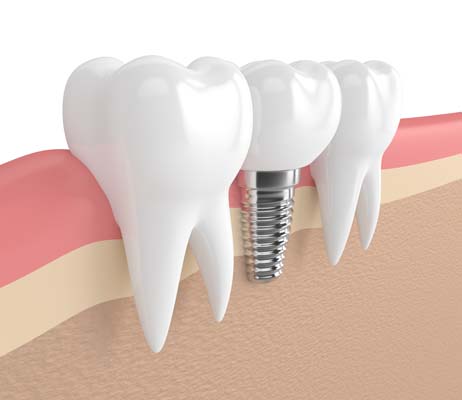Placing Crowns on Dental Implants
When you’re considering having dental implants surgery, you may be curious about the steps following the initial surgery of the implants into your mouth. The next stage is crown placement on dental implants. The crown will sit on top of the implant and work together to help your new teeth work and feel just like a natural tooth.
Crown placement procedure
After dental implants have been integrated into the bone, the dentist will then schedule another surgery. During this surgery, they will expose the top of the implant, placing a collar over it to help guide the gum tissue for proper healing. When the gum tissue has healed, the collar will be removed and replaced with abutment.
Before this can be done, your dentist will make impressions of the abutment to help make the dental crown of the implant. These impressions are made so that the crown will fit securely on your dental implant to cover any gap created by the loss of a tooth.
Temporary crowns
Before your permanent crown is fabricated, the dentist will place a temporary crown onto the implant. This will have to be removed before the permanent crown can be placed. A local anesthetic may be used to numb the area around the dental implants before the crown is removed. All traces of dental cement will be removed from the implants before the permanent ones are placed.
Ensuring a good fit
Before a dentist locks in your permanent crown, they will check to ensure they fit properly. This process is done by placing the crown on your implant without cementing or screwing it into place. If the crown doesn’t fit right, they will trim it down until the desired fit is achieved.
Placement of the permanent crown
During this stage, the dentist will seal the crown. When cement is used, they will put dental cement inside the crown and place it over your dental implants. After a few minutes, the cement should be set into place. If there is any excess cement left over, it will be cleaned, and they will recheck your bite to ensure they fit properly.
If your dentist uses a screw mechanism, they will screw the crown over the abutment until it has a firm placement. Screwed-in crowns are much more easily removed than cemented ones.
Caring for your crowns
After your permanent crowns have been placed, your dentist will then provide any aftercare instructions. Depending on what mechanism was used to secure the crowns in place, your aftercare instructions may differ. Dental cement can take a few hours to set, which may discourage you from using the crown for at least 24 hours. They may also advise that you check your bite again the following day once the cement has fully hardened.
Having dental crowns placed on dental implants is considered to be an easy, straightforward procedure. Follow any aftercare instructions that your dentist provides to ensure you get the best possible lifespan out of your new teeth.
Request an appointment here: https://ddsbaik.com or call Dennis Baik, DDS at (408) 226-5560 for an appointment in our San Jose office.
Check out what others are saying about our dental services on Yelp: Dental Implants in San Jose, CA.
[recent-blogs count=4 layout=”horizontal” category=”dental-implants-cat,dental-implant-candidate-cat,post-op-care-for-dental-implants-cat,the-dental-implant-procedure-cat,dental-implant-surgery-cat,dental-implant-restoration-cat,implant-dentist-cat”]


